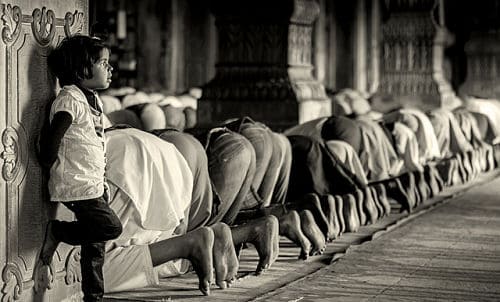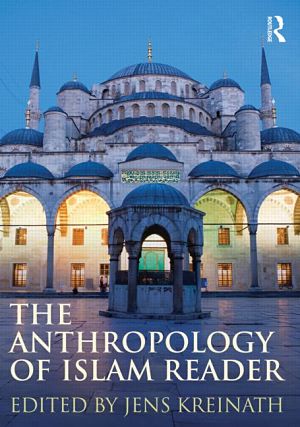Great dilemmas of selection, inclusion, and exclusion face the editor of an anthology of the anthropology of Islam. The papers selected for this volume trace a logical narrative thread commencing in Part I with Michael Gilsenan, dodging through Clifford Geertz, Abdul Hamid el-Zein, and Talal Asad. Part II interrupts the theoretical flow of the narrative to tour “religious practices,” including daily prayers (Saba Mahmood; Heiko Henkel), fasting in Ramadan (P. J. L. Frankl; Samuli Schielke), pilgrimage to Mecca (Raymond Scupin; Barbara M. Cooper), feast of sacrifice (John R. Bowen; Pnina Werbner), and almsgiving (Holger Weiss; Jonathan Benthall). Part III resumes the theoretical narrative thread to reflect upon “methodology” and “representation” via Akbar S. Ahmad, Richard Tapper, Edward Said, and Daniel Varisco. Glossaries of anthropological and Islamic terms follow.
Clearly, this volume is designed for the undergraduate or postgraduate reader, whose first formal encounter with Islam is presumably through this volume. On this level the book is effective.
Cherry picked edited snippets from Gilsenan facilitate an immediate introduction to the central structural features of Islam such as haddith and sunna, and alert the reader to the multiplicity of Islam(s), or at least to the multiplicity of ways in which this ‘religion’ is lived. The subtle manoeuvres of Geertz’s prose and the complexity of his thought should not blind us to his key insight – that “oppositional Muslims” (p. 73 ital. in original) were a product of the colonial encounter, where violence begets violence. El-Zein discusses Gilsenan, Gellner, and Geertz to reject the spurious dichotomy of ‘folk’ versus ‘formal’ (or elite) Islam (p. 89). One wonders if this solution should not also be extended to current debates concerning ‘false’ or ‘true’ Islam, where false Islam supposedly prioritises terror, and true Islam promotes peace. Asad closes out Part I, again rejecting the ‘Great’ and ‘Little Traditions’ (p. 97). Asad criticises the production of “dramaturgical” (p. 99) accounts of Islam, preferring historical, analytical, contextualised accounts, which is a not-so-subtle message to anthropologists to go and pack up their anthropological toolkits and settle back into their armchairs at home instead.
Mahmood’s chapter, which commences Part II with the section on Daily Prayers, is one of the better contributions to the volume. Mahmood discusses the dispositions of women’s ‘piety’ in Egypt (albeit with no mention of Simmel). Challenging Bourdieu’s formulation of habitus, Mahmood (p. 129) says that she has “tried to argue that the body’s conceptual relationship with the self and others, and the ways in which it articulates with structures of authority, varies under different discursive regimes of power and truth precisely because the body’s ritual practices endow it with different kinds of capabilities.” Following Mahmood’s chapter, Henkel’s chapter looks more anecdotal than ethnographic, and concerns insider ‘belief’ and ‘unbelief,’ recounted at the cost of his ‘outsider’ exclusion from the prayer in Turkey.
Frankl’s description of fasting in Swahili-Land introduces the next section, on Feasting During the Month of Ramadan – but this chapter had me asking, “so what?” Frankl’s chapter lacks analytical teeth and should have been pulled from the volume. Schielke’s accompanying chapter, set in Egypt, however, provides the very best essay, with a gritty and amusing account of Ramadan, criticising Mahmood along the way for the “problematic tendency to privilege the aim of ethical perfection” (p. 184), to offer an alternative focus on people’s fragmented biographies and ambivalent subjectivities (p. 185).
In the following section, Pilgrimage to Mecca, Scupin traces the significance of hajj for Thai Muslims; Cooper follows up with a tightly formulated essay on narrating one’s own narration in Hausa women’s performance of hajj.
In the next section of Part II, entitled Feast of Sacrifice, Bowen straddles Sumatra and Morocco for a discussion of Muslim sacrifice. Given that his fieldwork was conducted in 1978 this reads like a memoir, even a memorial; one that is ultimately inconclusive (but whether this was his fault or the editorial selection remains unclear). Following this, Pnina Werbner’s chapter on the ritual of ‘Sealing’ the Koran (khatam quran) among Pakistani migrants in Manchester had me again asking the “so what, who cares?” question, with her abstract “ontological” concern for “the role of fellow migrants as ritual mediators, effecting a desired transformation in the condition of individuals and their families” (p. 231). Werbner says that “The congregation were all friends…” (p. 235). Congregations, like parishes, priests, and churches, however, do not exist in Islam—these terms are Orientalist linguistic transpositions from Christianity. Ultimately Werbner’s account makes her own informants look like fools reading the entire Qur’an in the vain hope that they can find the correct verse for whatever ill might befall them.
The final section of Part II starts with Weiss on Almsgiving in Northern Ghana. Here, once more, we see history supplement anthropology. More interesting, Benthall, who conducted research in Jordan and the West Bank, raises the question of a progressive zakat [taxation] as a possible solution to the evils of communism and capitalism (p. 263) in a post-capitalist Islamic world.
Part III kicks off with Situating Anthropology, where Ahmed makes the case for an Islamic anthropology for and by Muslims. This is an interesting perspective, but unconvincing, because in my view to be an anthropologist one needs to be methodologically agnostic, otherwise the writer runs the risk of becoming an ideological apologist. Tapper attacks Ahmed’s position as ethnocentric, but the debate is still situated at the level of text, whether Islamic approaches to anthropology, or anthropological approaches to Islamic texts. This confuses literary theory with anthropology, a ‘postmodern turn’ fashionable twenty years ago, but hardly reflective of the current state of the discipline.
In the final section, Representing Islam, Said’s chapter examines how the media covers Islam. He concludes that to offset “many wars, unimaginable suffering, and disastrous upheavals,” non-Orientalist antithetical scholarship must not put itself at the service of power, but instead “at the service of criticism, community, dialogue and moral sense” (p. 320), which is, I suppose, another name for science, albeit a meaning Said may not have intended. The final chapter, by Varisco, at least mentions some of the many studies of Islamic mysticism in the anthropological canon, and even hints at transnationalism, but unfortunately does little more than list out the names of some of the more famous studies.
According to Krenaith, “[t]he aim of this Reader is to go beyond information given in introductory textbooks on Islam and reflect upon the adventure of anthropological research, its consequences for the researcher, and most importantly, for the understanding of the lives of those upon which the ethnographic volume of this volume is centred” (p. 14). Such modest ambitions may represent a wasted opportunity to learn how the self-avowed “religion of peace” came to be represented as the “religion of terror,” and this raises key questions concerning the role of violence in religion, and religion in violence.
Does the anthropology of religion/Islam tell us nothing of contemporary troubles post-9/11? Surely a discussion of violence would be more pressing and relevant to anthropological students of Islam than endless stale postmodern diatribes over ‘representation.’
A discussion of ‘power,’ however, might disrupt this conservative and dated selection of materials, and raise the spectre of Orientalism, which even “antithetical scholars” (p. 319) of Sunni community Islam, or Islamic communities, seem destined to fail to overcome. Contra Geertz’s ‘observations’ of ‘Islam,’ claims Varisco, it is preferable to study ‘Muslims,’ because “[t]he anthropologist observes Muslims in order to represent their representations; only Muslims can observe Islam” (p. 337). Varisco’s circuitous conclusion to the volume demonstrates just how gigantic a theoretical muddle The Anthropology of Islam Reader is lost within.
To conclude, in the glossary, the term “mystic” has the following bizarre definition: “As a term in the study of religion, it refers to an individual who is introverted and believes in an invisible realm and reality of enlightenment beyond human comprehension” (p. 362). This definition of ‘introverted believers’ is patently Orientalist. With this in mind it is just as well that the copious anthropological studies of Islamic mysticism, Sufism, are almost entirely absent from this volume.
Kreinath, Jens (ed.). 2012. The Anthropology of Islam Reader. London and New York: Routledge. 420 pp. PB: $60.95. ISBN: 978-0-415-78025-4








